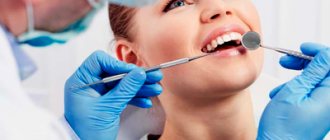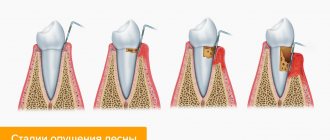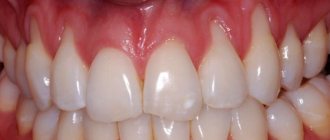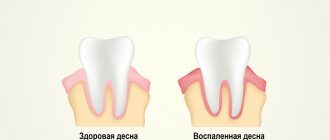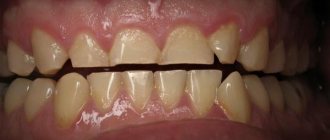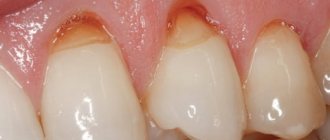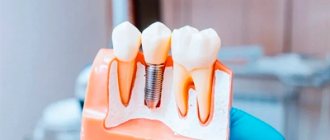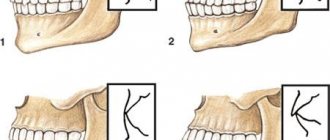Classification Causes of recession Diagnosis and consequences of recession Treatment methods Prevention
Gum recession is the process of loss of gum tissue, which exposes the neck of the tooth root. Visually it looks like this: due to the exposure of the root part, the teeth appear longer, and a small groove is formed at the edge of the gum. The sensitivity of teeth to sour, sweet, salty and temperature changes increases. Gum recession can occur in the area of one tooth or several. However, to establish an accurate diagnosis, you need to contact the dentist.
Where does the treatment of dental recession begin?
Treatment of recession must begin, first of all, by eliminating the cause - what caused it, what caused the gum recession.
After this, depending on the Miller class, surgical treatment is performed - closing the exposed area. Since gum recession occurs in conditions of a broken bite, it is logical to begin treatment in order to stop the process of recession itself. And here we should note the professionalism of our orthodontists.
We, at the German Implantology Center, effectively follow the approach: first we correct the bite and stop the recession, and only then we treat the recession itself and restore the gum level. To immediately restore gums without eliminating the cause is a symptomatic treatment, extremely ineffective and, in fact, useless.
Our clinics value the time of our patients and offer only proven treatment methods that meet the principles of reliability and effectiveness in the long term.
Diagnosis and consequences of gum recession
Timely diagnosis of gum recession helps to quickly eliminate the problem and prevent the development of unpleasant consequences. To carry out self-diagnosis, you need to know the following symptoms:
- the gums are red and inflamed;
- some teeth look longer than others;
- Gaps have appeared between the roots of the teeth and continue to grow;
- high sensitivity of teeth appeared;
- there is an unpleasant odor from the mouth.
If one or more signs are detected, you must immediately consult a dentist to immediately begin treatment for receding gums. Otherwise, in addition to physical discomfort, the risk of developing caries and pulpitis increases. This happens due to the active proliferation of bacteria in the root part of the tooth, where the enamel is thinnest. Ultimately, if the process is left to chance, it will lead to loosening of the teeth and even their loss.
The more advanced the disease, the more difficult the treatment and the more the cost of such an operation increases. Therefore, there is no point in delaying a visit to the clinic.
About orthodontic treatment to stop gum recession
These can be orthodontic structures: braces, or aligners, or something else - this is what the orthodontist will choose, it is he who determines which technique for correcting the bite in a given case of recession will be best applicable for each specific patient. There are no universal treatments. The only question that is subject to discussion is how long orthodontic treatment will take in one way or another.
As a result of treatment, the orthodontist must place the teeth in a physiological occlusion so that the tooth/teeth do not bear such a load that they experience excessive chewing stress at the time of contacting the doctor.
And then, when the tooth is placed in the functionally correct position, the following happens to the gum. Gum recession stops. And again, if it stops at such a level that closing the recession is possible, then the gums subsequently rise and the recessions close.
And after some intervention, perhaps the gums will return in full.
Cases where orthodontic treatment eliminates recession
We cannot always close all gum recessions with the help of orthodontics. We remove the cause of the recession, that is:
- malocclusion,
- we correct occlusal contacts that lead to this recession,
- eliminating improper stress on teeth,
- We eliminate the lack of load in the case of an extracted tooth and the overload, in turn, of neighboring teeth.
And after the doctor has normalized the patient’s bite and normalized the correct closure of his teeth, we refer him to a periodontist who will perform gum plastic surgery.
In any case, the pathological process of gum loss stops after our treatment; it no longer progresses. And we always wait after removing braces (or other orthopedic structures) from 3 to 6 months
for the gums to recover and calm down. And after this, if necessary, plastic surgery of the frenulum, plastic surgery of the vestibule of the oral cavity is performed - all this is done only after orthodontic treatment.
Why is plastic surgery done AFTER, and not BEFORE, bite correction?
Because a scar is formed inside the operated tissue, which in the future can interfere with the movement of teeth when correcting the bite.
Causes of receding gums
Gum recession can be caused by various factors. Self-diagnosis is the first step to identifying the problem, so as not to pay too high a price for inattention. Below are the most common causes of recession:
- improper
oral hygiene. For example, too aggressive brushing of teeth: using a hard toothbrush, mechanical damage during dental care; - lack
of oral care. If plaque is not removed, it will lead to the formation of tartar, which in turn causes gum disease and recession; - periodontal disease
. This gum disease is often accompanied by gum recession. If treatment is not done in time, this will lead to tooth loss; - natural aging
of the body; - bad habits
: biting lips and nails, biting pens, pencils, smoking; - traumatic, inaccurate dental treatment
, including whitening procedures.
In addition, structural features
oral cavity, jaw (bite pathology, arrangement of individual teeth, shortened lip frenulum, etc.) and somatic diseases (metabolic syndrome, diabetes mellitus, etc.).
Surgery to close gum recession
The gum itself, as you understand, will not rise, it will not “bounce into place”, it needs to be put back in its original place, and this is called closing the gum recession.
But I repeat once again: there are also indications and contraindications for the operation, in accordance with certain classes of gum recession according to Miller.
If this is a class one recession, then one forecast. If this is class II gum recession, the prognosis is different. There are many contributing factors to both successful gum recession and failure. That is, at the very beginning of the treatment path, the doctor must determine all the factors for successful closure of gum recession.
What to do to prevent the disease?
Preventive measures do not provide a 100% guarantee that you will never experience gum recession, but following them will help minimize the risks:
- regular and high-quality hygiene;
- professional cleaning of dental plaque;
- using a medium-hard toothbrush and proper brushing technique;
- timely diagnosis of caries and inflammatory processes;
- taking vitamins and amelogenin if there are risks of recession;
- giving up bad habits, especially smoking;
- correction of malocclusions, if you have them.
Miller classification
Today, the generally accepted classification of gum recession is the Miller classification, which is divided into 4 classes
.
First and second classes
according to Miller - root closure is 100 percent possible.
Third class
according to Miller, 100 percent root closure is impossible.
And fourth grade
according to Miller, he is not even being treated.
What treatments are available for each stage of gum recession?
For the first, second and third classes according to Miller - only surgical closure of the exposed necks of the roots of the teeth. The fourth class according to Miller is not treatable, that is, it cannot be treated.
Is there an age limit for treating gum recession?
No.
There is no age limit for treating gum recession.
general information
The result of gum recession is that the bottom of the tooth is exposed. As a result, not only an aesthetic problem arises, but also the possibility of developing serious pathologies, such as wedge-shaped defects. Increased sensitivity of enamel, caries, etc.
This disease is quite rarely diagnosed at a young age (no more than 10% of patients).
Its manifestation is most often observed in middle and old age. Important! Gum recession belongs to the group of diseases that can have a negative impact on the facial aesthetics and psycho-emotional state of the patient. When you smile, the exposed roots of the teeth are clearly visible, which has an overwhelming effect on self-esteem, causing difficulties in communication and difficulty in social adaptation. And the more pronounced this pathology is, the stronger the person’s psychological uncertainty will be.
Ointments and gels
The main advantage of gels and ointments compared to rinses is their ability to remain longer on the surface of the gum mucosa - and, as a result, provide a therapeutic effect for a longer time. ASEPTA healing gel contains propolis, a component of natural origin that has antibacterial, anti-inflammatory and regenerating effects. Thanks to this, the gel, when used regularly, can eliminate almost all the unpleasant symptoms that accompany weakening gums, as well as have a positive effect on the condition of the tissues themselves. The product is applied twice a day to the affected areas (necessarily after thorough brushing of the teeth). After using it, do not consume food or liquid for half an hour. This gel allows you to quickly strengthen your gums at home.
An equally effective remedy is the adhesive balm ASEPTA. The sticky pectin base prevents saliva from washing off the balm from the surface of the mucous membrane - its antimicrobial effect lasts more than half an hour. The balm contains powerful antiseptic components - chlorhexidine and metronidazole, which can prevent the development of inflammatory gum diseases - gingivitis and periodontitis.
Clinical picture during the development of recession
As the disease develops, the gums on the lower teeth recede and those on the upper teeth rise. The roots are gradually exposed. They are not covered with enamel, as a result of which they lack protection. Because of this, tooth sensitivity increases. Visually they look elongated, their color changes at the gums. Interdental gaps form, in which food constantly gets stuck, which brings a lot of inconvenience. In advanced cases, bleeding appears and the gums become inflamed.
The pathology can be localized, that is, affect 1-2 teeth, or generalized, when the entire dentition is involved in the painful process.
Treatment methods – therapeutic and surgical
*Photos before and after recession treatment
Typically, surgical and non-surgical (therapeutic) methods are used. Each of them depends on the severity of the disease. But operations are more popular because they are more effective and reliable.
If we talk about surgical intervention, it is divided into techniques:
- Lateral flap technique. Using special tools, inflammation and deposits on teeth are eliminated. Next, a flap is formed and the tissue is sutured.
- Resorbable membranes. In this situation, a high rigidity membrane is installed. After which it is deleted. But the procedure does not provide a 100% guarantee of complete recovery, so this method is avoided.
- Regeneration. For this purpose, certain components (proteins and enzymes) are used to form renewed healthy gums.
Non-surgical treatment includes collagen therapy. As a rule, it has an effect only at the initial stage of a recession. The damaged area is restored quite quickly, returning a healthy appearance.
Folk remedies for treating illness
Regular rinsing of the mouth with special solutions or decoctions of medicinal plants is an excellent remedy for strengthening the gums. For this purpose, you can use decoctions of oak bark, eggplant peel, and horseradish. The most popular herbs for strengthening gums are chamomile, sage, St. John's wort, mint, and burdock.
Four folk recipes for rinsing to strengthen gums:
- Tea tree oil is an effective remedy for strengthening weak gums due to its ability to heal wounds and fight bacteria. To prepare a solution that needs to be used to rinse the mouth, take 2 drops of oil and half a glass of clean water.
- One of the popular folk recipes is a tincture made from a mixture of linden blossom and oak bark in equal proportions. To prepare it, just take a teaspoon of each component and pour 2 cups of boiling water over them. You should rinse your mouth with the resulting product after each meal.
- You can disinfect the oral cavity with cognac. To do this, you need to rinse it with a small amount of drink.
- Burdock decoction. The product should be used at least twice a day. To prepare it, you need to boil a tablespoon of the herb in 500 milliliters of water, then cool and strain through cheesecloth or a sieve.
To strengthen the gums and teeth, it is recommended to massage with the thumb and forefinger. The gums are treated with vertical massaging movements - from one tooth to another. Each section should be worked for 20 seconds. To increase efficiency, you can carry out the procedure by first dipping your fingers in honey or tea tree oil.
To strengthen the gums, it is recommended to use lotions:
- Plantain juice helps a lot. A cotton or gauze swab is moistened in it and applied to the gum.
- A decoction of young pine needles. To prepare the lotion, you need to boil 3 tablespoons of needles in 200 milliliters of water for 10 minutes. After this, the product is infused for at least 7 hours. A cotton swab dipped in the broth is applied to the sore gums.
Consumer Reviews
Kotty about Asepta adhesive gum balm (otzovik.com)
“I had to purchase this adhesive balm because the dentist diagnosed me with periodontal disease. Therefore, when I have gum inflammation, I use this drug in courses every 6 months. I must note that the drug very quickly exerts its healing effect on the gums. The pain goes away immediately after starting treatment.
The dentist recommended that I lubricate my gums at night, once a day for 7 days.
Having studied the composition, I saw there such a substance as metronidazole and chlorhexidine. I realized that metronidazole is still an antibiotic. But since I was prescribed this medicine, I was calm. Although, frequent use of substances such as chlorhexidine and metronidazole on the skin and mucous membranes is undesirable, because the protective properties that the mucous membrane and skin should produce may cease to be produced. The dentist told me this too. Therefore, it is very important to use such products only for their intended purpose and strictly according to the instructions.
Of the indicated effects of the balm on the gums, the following were indicated:
- pronounced antibacterial effect on the gums;
- relieving inflammation and bleeding gums;
- breath freshening.
The package also contained a special plastic spatula, which was used to apply the balm to the gums. I must say that it is very comfortable. The balm itself is very thick and hardens after application. But the taste is generally tolerable.
I am satisfied with the effect of the balm. Good quality. It's not that expensive, considering that it lasts a long time. I recommend".
Minuto4ka about Asepta mouthwash (otzovik.com)
“Mint is an acquired taste, in everything. For example, I can completely tolerate it and love it. But I know a lot of people who can’t stand tongue-biting additives.
These are the first associations that arose for me when I first used this mouthwash.
It is sweet and has a lime flavor. And absolutely non-biting.
They prescribed it to me for absolutely no reason, of course.
My dentist prescribed it for me. For gums, which really bother me due to the periodic eruption of wisdom teeth. Which I'm terrified of deleting.
The rinse aid is sold in pharmacies, I haven’t seen it in supermarkets, which captivates me. I would like to believe that it is truly therapeutic in nature. They prescribed me this mouthwash along with Asepta dental gel. I don’t know which of them helped in the end. Maybe all together.
I think the advantage of the bottle is the presence of a measuring cup. It is very comfortable. Not all mouthwashes have it...
... overall I recommend it. At least it will win over its audience with its taste.”
Sources:
- Study of the clinical effectiveness of the use of therapeutic and prophylactic agents of the ASEPTA series in the treatment of inflammatory periodontal diseases in children and adolescents (I.V. Klimova) Irina Vladimirovna Klimova, Candidate of Medical Sciences, Associate Professor of the Department of Pediatric Dentistry, Novosibirsk State Medical University. Department of Pediatric Dentistry, Novosibirsk State Medical University.
- Clinical studies of antisensitive toothpaste “Asepta Sensitive” (A.A. Leontyev, O.V. Kalinina, S.B. Ulitovsky) A.A. LEONTIEV, dentist O.V. KALININA, dentist S.B. ULITOVSKY, Doctor of Medical Sciences, Prof. Department of Therapeutic Dentistry, St. Petersburg State Medical University named after. acad. I.P. Pavlova
- Report on clinical trials to determine/confirm the preventive properties of commercially produced personal oral hygiene products: mouth rinse "ASEPTA PARODONTAL" - Solution for irrigator." Doctor of Medical Sciences Professor, Honored Doctor of the Russian Federation, Head. Department of Preventive Dentistry S.B. Ulitovsky, doctor-researcher A.A. Leontiev First St. Petersburg State Medical University named after academician I.P. Pavlova, Department of Preventive Dentistry.
- The role of anti-inflammatory rinse in the treatment of periodontal diseases (L.Yu. Orekhova, A.A. Leontyev, S.B. Ulitovsky) L.Yu. OREKHOVA, Doctor of Medical Sciences, Prof., Head of Department; A.A. LEONTIEV, dentist; S.B. ULITOVSKY, Doctor of Medical Sciences, Prof. Department of Therapeutic Dentistry of St. Petersburg State Medical University named after. acad. I. P. Pavlova
In simple words about a complex disease
What is gum recession? This is a pathology of the soft tissues of the oral cavity, which is characterized by a decrease in the mobile (marginal) level of the gum in the apical direction and exposure of the neck and root part of the teeth. Most medical reference books give approximately this definition. In simple terms, the gum literally moves down or up, exposing the tooth. Visually, this resembles low tide, when the water level decreases and the hitherto hidden relief of the coast appears.
Gum recession can occur at any age. However, the disease most often develops in people over fifty years of age. At this age, many patients experience loss of soft tissue edge height, but in most cases this is not very noticeable. The risk of a recession can be predicted. If the fixed and cervical parts of the gum are approximately equal in size, then the likelihood of recession is very high, since ideally the attached part of the gum should be much wider. It is also important to understand that in most cases, recession is a consequence of other diseases and pathological processes. This is why it is important to identify the root cause to create the optimal treatment plan.
Is gum grafting painful?
No . Operations to eliminate gum recession are performed under local anesthesia; the surgical intervention is 100% painless. In the postoperative period, especially with gum plastic surgery using local tissues, patients often do not experience pain at all. If pain occurs, it is usually only on the day of surgery, a couple of hours after the intervention, when the effect of the local anesthetic wears off. During this period, the pain is perfectly eliminated with painkillers prescribed by the doctor. During the entire rehabilitation period, on average, 1-2 painkiller tablets are required.
In cases of gum plastic surgery using a “patch,” unpleasant sensations may be added due to the presence of a donor zone, which, according to patients, resembles the feeling “as if you grabbed hot tea,” but this does not always occur. The presence/absence of pain is determined by the area from which the “patch” is taken. If anatomical conditions allow, doctors can remove the graft from the donor area absolutely painlessly.
Prevention
In order to significantly reduce the risk of developing this disease, experts advise their patients to follow these rules:
- It is necessary to carry out timely treatment of caries, since it is the main cause of the development of recession.
- Visit your dentist regularly for preventative checkups. The earlier this pathology is diagnosed, the less time and effort will be spent on eliminating it.
- Avoid injury and bleeding gums. To do this, it is necessary to correct malocclusions using the most gentle methods possible, periodically strengthening tooth enamel through remineralizing therapy.
- It is necessary to pay significant attention to high-quality oral hygiene. Brush your teeth properly and do not use a brush with too hard bristles.
Gum recession is a serious disease that requires prompt intervention from a specialist. Therefore, it is necessary to periodically undergo a preventive examination at the dentist and practice proper oral hygiene.
Diet and vitamins
Proper, balanced nutrition is necessary for gum health. To strengthen the mucous membranes and blood vessels, you need to eat foods high in vitamin C, such as citrus fruits and green leafy vegetables. Vitamin K, found in large quantities in green vegetables and herbs, has a similar effect. Antioxidants and tannins contained in green tea and red wine have an anti-inflammatory and healing effect, slowing down the aging process. In addition, it is important to consume enough phosphorus, calcium and zinc - they are contained in seafood, garlic and onions, and dairy products.
Vitamin complexes are well suited as an additional source of nutrients - in particular, the vitamin-mineral complex for teeth ASEPTA. It contains vitamins A, B3 and B6, C, D3, as well as coral calcium and green tea extract. In addition, coenzyme Q10, which is contained in the complex, has a powerful regenerating effect and restores damaged gum tissue.
How to strengthen teeth and gums? Basic recommendations
List of recommendations for strengthening gums:
- Use special toothpastes.
- Introduce dairy products into your diet, as well as foods containing large amounts of vitamin D.
- Use rinse aids.
- Use floss to clean teeth in hard-to-reach areas.
- See your dentist regularly to check the condition of your teeth and gums.
See your dentist regularly to check the condition of your teeth and gums.
